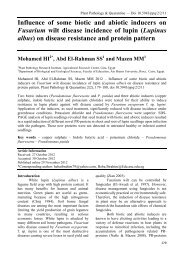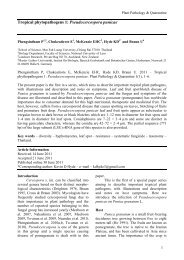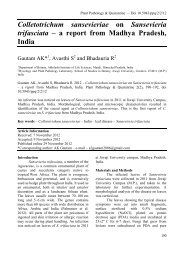Genus Cercospora in Thailand: Taxonomy and Phylogeny (with a ...
Genus Cercospora in Thailand: Taxonomy and Phylogeny (with a ...
Genus Cercospora in Thailand: Taxonomy and Phylogeny (with a ...
You also want an ePaper? Increase the reach of your titles
YUMPU automatically turns print PDFs into web optimized ePapers that Google loves.
Plant Pathology & Quarant<strong>in</strong>e<br />
Fig. 1 – Various types of cercospora leaf spot symptoms on leaves: a. Carica papaya, b. Lactuca<br />
sativa, c. Kopsia fruticosa <strong>and</strong> d. Lactuca sativa (cultivar head lettuce). (Meeboon et al. 2007c).<br />
may be conspicuous by thickened walls <strong>with</strong><br />
dark coloration (Figs 3c–d) or <strong>in</strong>conspicuous<br />
(Hennebert & Sutton 1994). A scar on a<br />
conidium at the po<strong>in</strong>t of former attachment to<br />
the conidiophore is termed the hilum<br />
(Hennebert & Sutton 1994). The genus<br />
<strong>Cercospora</strong> is characterized by conspicuous,<br />
thickened <strong>and</strong> darkened scars <strong>and</strong> hila (Crous<br />
& Braun 2003).<br />
The development of a conidium from the<br />
conidiogenous cell or conidiophore is called<br />
conidiogenesis (Hennebert & Sutton 1994).<br />
Cercosporoid fungi conidiogenesis is characterized<br />
by blastic, sometimes determ<strong>in</strong>ate but<br />
often sympodial proliferation, mostly schizolytic<br />
conidial secession <strong>with</strong> s<strong>in</strong>gle or conidia<br />
<strong>in</strong> cha<strong>in</strong>s. Blastic conidiogenesis is characterized<br />
by an elastic wall of the conidiogenous<br />
cells, bulg<strong>in</strong>g out to form a conspicuous,<br />
enlarged conidium <strong>in</strong>itial (Hennebert & Sutton<br />
1994). It may be holoblastic [all wall layers of<br />
the conidiogenous cells contribute towards the<br />
formation of the conidium (blastoconidia)] or<br />
enteroblastic (only the <strong>in</strong>ner wall of the conidiogenous<br />
cell contributes towards the formation<br />
of the conidium) (Hennebert & Sutton<br />
1994). Blastic conidiogenous cells may be<br />
monoblastic (only <strong>with</strong> a s<strong>in</strong>gle conidiogenous<br />
15









